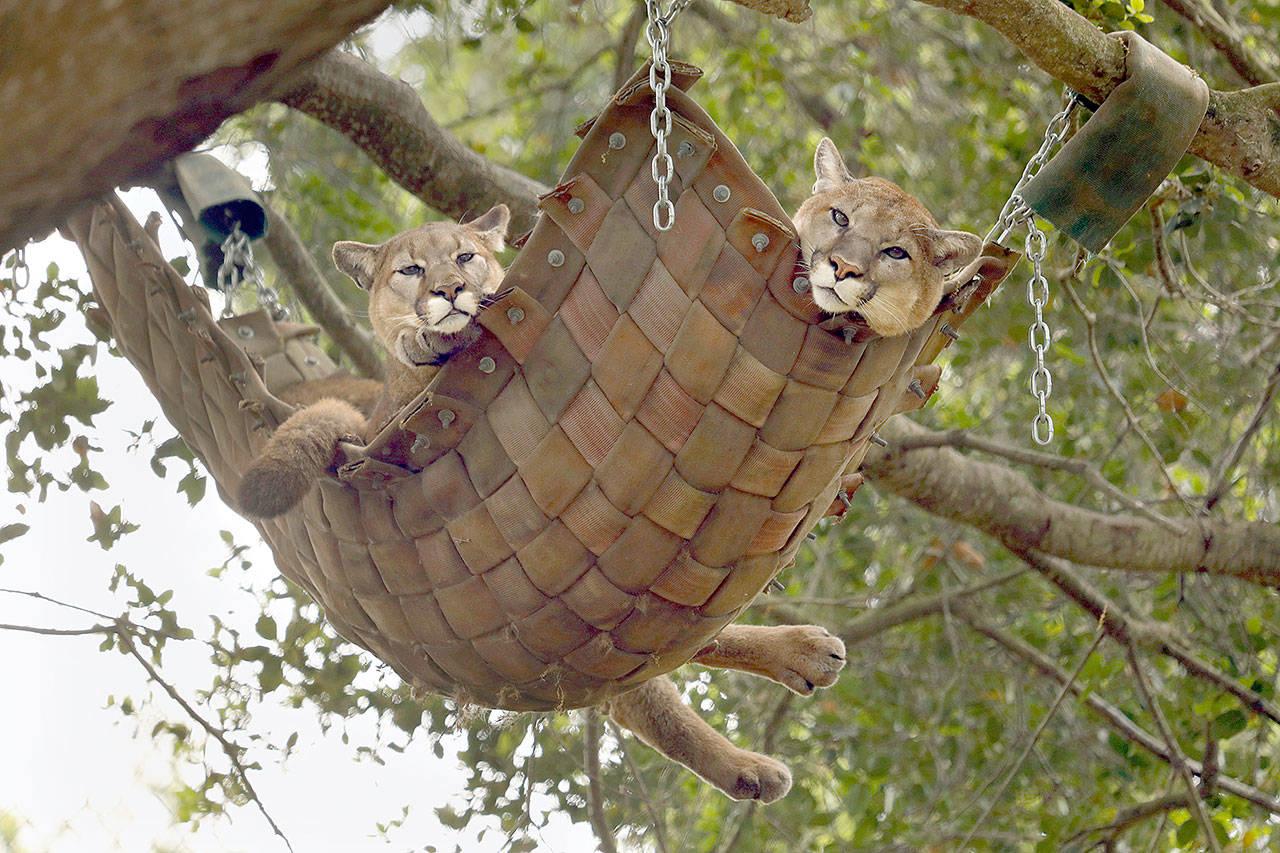OAKLAND, Calif. — While animals in deserted national and state parks seem to be thriving without the presence of people, many at the Oakland Zoo seemed downright bored without the crowds.
On Monday morning, a pair of mountain lions lolled together lazily in a hammock, while a gibbon couple, Rainer and May, sang and called, before dejectedly lying back in the high branches of the Chinese elm they call home.
Since March 17, the Oakland Zoo, a 100-acre wildlife park, has been closed to visitors — by order of state and local governments requiring the public to shelter in place during the coronavirus pandemic.
According to the zookeepers, only the bald eagles, and maybe the wolves, seem to relish the solitude.
“The eagles are using parts of the enclosure we’ve never seen them use before,” said Joel Parrott, the zoo’s president and chief executive,
On Monday, a bald eagle that was resting in this newfound area, close to the pedestrian walkway, retreated back to hide in the cover of the trees when a visitor approached.
All of the more than half-dozen zookeepers interviewed for this story said visitors offered a form of stimulus for most animals.
However, Leslie Storer — who was slingshotting food into the grizzly enclosure Monday —also wondered if the animals were resting more because they were more relaxed without the normal crowds.
“It’s hard to know which it is,” she said.
While the animals have been afforded some downtime, the keepers, vet staff and administrators haven’t had the same luxury.
According to Parrott, it costs roughly $800,000 a year to feed the animals and $24 million a year to run the zoo. Finding that money, while attendance is at zero, is a daunting task.
Other zoos nationwide are confronting similar challenges. In Southern California, San Diego Zoo Global, which operates the San Diego Zoo and a sister facility, the San Diego Zoo Safari Park, spent about $231 million in 2018 on animal care and exhibition operations. In 2018, the nonprofit organization reported revenues of $342 million, much of which will be wiped out, depending on how long the two zoos remain closed.
In Oakland, the zoo qualified for an eight-week loan as part of the federal Paycheck Protection Program. That is enabling the zoo to maintain a full-time crew of keepers, veterinarians and vet staff.
But that still leaves them short. To help cover part of the remaining shortfall, the zoo has launched a subscription-based Facebook feed, which offers viewers a behind-the-scenes look at the animals and staff.
On Monday, a zoo-based marketing crew was filming an episode about goat-hoof trimming at the petting farm at the base of the hill.
The goats seemed thrilled to have people around, jogging to the fence as visitors approached and braying until they were petted.
Erin Harrison, vice president of marketing and communications for the zoo, said the show was bringing in roughly 100 subscribers per day, at tiered pricing for members and nonmembers.
Although that’s helping somewhat, actually finding food has become a challenge.
Keepers rely on local landscaping and tree-trimming services to provide “browse” for the elephants, giraffes and camels —excess tree branches, sticks and grass.
The staff is now relying on individual donations from neighbors, and the stockpile is getting low. That’s especially true for the giraffes, who, unlike the camels, are very picky about the browse they will eat.
“It can’t have anything on it,” said Alyssa Watt, as she fed the non-discriminating camels. “The giraffes won’t eat it if it has dust on it, ash, or even the slightest hint of a chemical odor.”
And she said washing the browse doesn’t help. They’ll still reject it.
Most of the animals at the zoo are rescues — taken from circuses, private owners or, in the case of the animals in the California exhibit, found orphaned in the wild.
The four grizzlies, two sets of cubs, were found in Alaska. Their mothers were killed for being “nuisance” bears.
And at the veterinary hospital on campus, four parrots had been brought in the day before —rescues from Wildlife Waystation, a wildlife preserve in Sylmar that ran out of money during the recent economic downturn.
The parrots were sitting quietly in some branches, their feathers puffed out, suggesting a level of stress and maybe underlying health issues, said Ilona Kovary, a keeper at the hospital.
The birds will remain here for the next 30 days, quarantined from the rest of the zoo, and tended to until a new home can be found for them.
All animals brought to the zoo must be quarantined for 30 days, said Parrott, the zoo director and a veterinarian by training.
The spread of disease is not a new concern for zoo staff. Even so, they are taking special precautions during the COVID-19 pandemic —especially after news that a Malayan tiger at the Bronx Zoo was infected by a keeper.
All of the keepers at the zoo Monday were wearing masks.
And in the hospital, where a mountain lion cub was brought in at the beginning of the month, social distancing and quarantine measures were even stricter. A clean set of footwear is required if visitors approach her cage.
The animal, found in a tree in the Bakersfield area, weighed only 9 pounds when the zoo brought her in.
She is now almost 24 pounds, although feeding her is not easy: She is extremely wary of people, and therefore cautious about eating while anyone is looking.
She growled and hid under a wooden pallet on Monday as visitors attempted to watch her during feeding time.
But as soon as they gave up and walked away, she darted out and ate the food and milk that had been left for her.
Like the bald eagles and maybe the wolves, this cub seems happier without people around.


